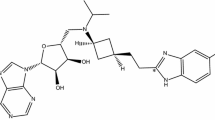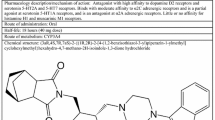Abstract
The pharmacokinetic properties of the iminodibenzyl antipsychotic drugs clocapramine (CCP, 3-chloro-5-[3-(4-carbamoyl-4-piperidino piperidino) propyl]-10, 11-dihydro-5H-dibenzo[b, f]azepine) and Y-516 (3-chloro-5-[3-(2-oxo-1, 2, 3, 5, 6, 7, 8, 8a-octahydroimidazo [1,2-a] pyridine-3-spiro-4′-piperidino) propyl]-10, 11-dihydro-5H-dibenzo[b, f]azepine) were investigated in dog and man. Dogs were administered CCP and Y-516 intravenously, intraperitoneally, and orally, and the concentrations of the parent drugs and their metabolites in the plasma and urine were determined. Half-life (t1/2) was approximately the same by all three administration routes, being approximately 5 h for CCP and 3 h for Y-516. Bioavailability following oral administration was 0.16±0.01 (mean ± SD, n=3) for CCP and 0.29±0.07 for Y-516. The fractions of dose absorbed following oral administration were 0.43±0.07 and 0.79±0.24, and the fractions of dose metabolized in the liver due to the first-pass effect were 0.63±0.05 and 0.63±0.04 for CCP and Y-516, respectively. Y-516 was detected in the plasma after intraperitoneal and oral administration of CCP. The ratio of the AUC of Y-516 to that of CCP was 0.06 following intraperitoneal administration and 0.40 following oral administration. This indicated that while the metabolism of CCP into Y-516 may occur partly in the liver due to the first-pass effect, it occurs mostly within the gastrointestinal tract itself or its mucosa. When CCP and Y-516 were given orally to man, the plasma concentrations of both parent drugs increased in a dose-dependent manner. The t1/2 of CCP at a dose of 50 mg was 46±6 h (n=3) while that of Y-516 at a dose of 25 mg was 15±2 h (n=5), so that elimination from the circulation was slower than in the dog in both cases. As in the dog, Y-516 was detected in the plasma following administration of CCP, but its concentration was approximately one fifth that of CCP and lower than that found in the dog. From the ratios of Y-516 produced upon oral administration of CCP in dog and man, we concluded that Y-516 is involved to a considerable degree in the pharmacological action of CCP in the dog and, though to a lesser degree, in man as well.
Similar content being viewed by others
References
Cohen BM, Herchel M, Miller E, Mayberg H, Baldessarini RJ (1980) Radioreceptor assay of haloperidol tissue levels in the rat. Neuropharmacology 19:663–668.
Denker H, Denker SJ, Green A, Nagy A (1976) Intestinal absorption, demethylation and enterohepatic circulation of imipramine. Clin Pharmacol Ther 19:584–586.
Fukuda T, Setoguchi M, Morimoto Y, Shoji H, Tsumagari T, Maruyama Y (1985) Neuroleptic properties of Y-516, a new iminodibenzyl derivative. Folia Pharmacol Jpn 86:197–208.
Gibaldi M, Perrier D (1982) Drugs and the pharmaceutical science, vol 15, Pharmacokinetics. Dekker, New York
Gilette JR, Pang KS (1977) Theoretic aspects of pharmacokinetic drug interactions. Clin Pharmacol Ther 22:623–639.
Gram LF, Christiansen J (1975) First-pass metabolism of imipramine in man. Clin Pharmacol Ther 17:555–563.
Greenblatt DJ (1978) Determination of desmethyldiazepam in plasma by electron-capture GLC: application to pharmacokinetic studies of clorazepate. J Pharm Sci 67:427–429.
Kurihara M, Tsumagari T, Setoguchi M, Fukuda T (1982) A study on the pharmacological profile of clocapramine. Int Pharmacopsychiatry 17:73–90.
Kurihara M, Itoh H, Katoh N, Kawakita Y, Kudoh Y, Mori A (1983) Clinical evaluation of clocapramine (Clofektion) in schizophrenia — a double blind comparison of clocapramine, haloperidol and perphenazine. Jpn J Clin Psychiatry 12:519–538.
Lukas G, Brindle SD, Greengard P (1971) The route of absorption of intraperitoneally administered compounds. J Pharm Sci 61:70–74.
Nakanishi M, Imamura H, Matsui E, Kato Y (1970) Studies on psychotropic drugs. IV. Metabolic fate of tritium labelled carpipramine in rats. Yakugaku Zasshi 90:204–208.
Nakanishi M, Kato Y, Furuta T, Arima N (1971) Studies on psychotropic drugs. XII. Metabolic fate of Y-4153 (I). Yakugaku Zasshi 91:1042–1046.
Nelder JA, Mead R (1965) A simplex method for function minimization. Computer J 7:308.
Setoguchi M, Sakamori M, Takehara S, Fukuda T (1985) Effects of iminodibenzyl antipsychotic drugs on cerebral dopamine and α-adrenergic receptors. Eur J Pharmacol 112:313–322.
Shader RI, Georgotas A, Greenblatt DJ, Harmatzs JS, Allen MD (1978) Impaired absorption of desmethyldiazepam from clorazepate by magnesium aluminium hydroxide. Clin Pharmacol Ther 24:308–315.
Yoshitomi Pharmaceutical Industries, Ltd. Jpn Kokai Tokkyo Koho 128782 (1981) Chem Abstr, 96. 122793p (1982)
Author information
Authors and Affiliations
Rights and permissions
About this article
Cite this article
Ishigooka, J., Murasaki, M., Wakatabe, H. et al. Pharmacokinetic study of iminodibenzyl antipsychotic drugs, clocapramine and Y-516 in dog and man. Psychopharmacology 97, 303–308 (1989). https://doi.org/10.1007/BF00439442
Received:
Accepted:
Issue Date:
DOI: https://doi.org/10.1007/BF00439442




